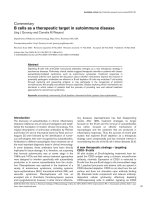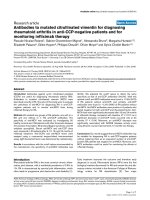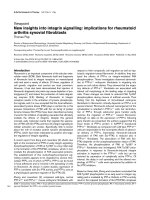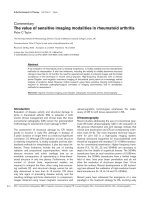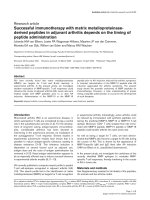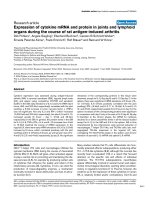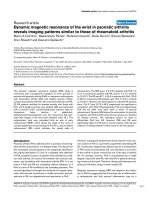Báo cáo y học: "Inflammation, carotid intima-media thickness and atherosclerosis in rheumatoid arthritis" doc
Bạn đang xem bản rút gọn của tài liệu. Xem và tải ngay bản đầy đủ của tài liệu tại đây (39.03 KB, 2 trang )
Page 1 of 2
(page number not for citation purposes)
Available online />Abstract
Carotid intima-media thickness (cIMT) reflects early atherosclerosis
and predicts cardiovascular events in the general population. An
increased cIMT is present in patients with rheumatoid arthritis,
compared with control individuals, from the early stages of the
disease and is thought to indicate accelerated atherosclerosis, but
direct evidence is not available. Whether cIMT is susceptible to rapid
and potentially reversible change depending on the intensity of
inflammation in states of high-grade systemic inflammation, such as
rheumatoid arthritis, remains unknown. If this is the case, an
increased cIMT in such disease states may not reflect structural
vessel wall damage, and may not be a good predictor of future
cardiovascular events in these particular populations. Prospective,
long-term, longitudinal studies are needed to address these
questions.
Carotid intima-media thickness (cIMT) was recently reported
by Hannawi and colleagues to be higher in rheumatoid
arthritis (RA) patients with recent disease onset compared
with age-matched and sex-matched control individuals [1].
The noninvasive measurement of cIMT is thought to reflect
structural vessel changes at relatively advanced, but still
subclinical, stages of atherosclerosis. cIMT is a strong
predictor for future vascular events in the general population,
particularly in people with low-grade inflammation as
assessed by C-reactive protein levels [2].
cIMT has previously been found to be increased in patients
with longstanding RA [3]: those with long duration
(> 20 years) had a higher cIMT compared with patients of the
same age but shorter disease duration (< 7 years). Hannawi
and colleagues extend these findings by reporting that an
increased cIMT was already evident in RA patients as early as
within 12 months of symptom onset and was determined
mainly by age and C-reactive protein [1]. Both research
groups conclude that their findings support the concept that
the high-grade inflammation associated with RA, in addition
to causing joint disease, also accelerates the process of
atherosclerosis in these patients. Hannawi and colleagues
suggest explicitly that ‘inflammation which precedes the
onset of joint symptoms in RA promotes the development of
atherosclerotic disease well before the first manifestations of
joint disease …’ [1]. This would be consistent with studies
showing that, compared with people who do not develop RA
later in life, those who do develop the disease have elevated
C-reactive protein levels many years before the diagnosis of
RA [4].
Whether cIMT is a good predictor of future vascular events in
patients with RA remains an open question, since no long-
term studies have to date documented such an association in
this particular population. Highly pertinent to this is whether
studies such as those discussed above do indeed provide
evidence for accelerated atherosclerosis in RA or reflect
alternative processes. The assessment of cIMT in RA cohorts
has thus far been limited almost exclusively to cross-sectional
studies. These studies are only good for hypothesis
generation, rather than proof of an association or its
directionality. The cross-sectional association of increased
cIMT with (current) C-reactive protein levels in the study of
Hannawi and colleagues is a good example. Could increases
in cIMT, in conditions with high-grade inflammation such as
RA, simply reflect current (but quickly reversible) inflammation
of the vessel wall rather than more permanent structural
vessel changes? And would a single measurement of cIMT in
this context be a good predictor of future vascular events in
patients with RA?
Editorial
Inflammation, carotid intima-media thickness and
atherosclerosis in rheumatoid arthritis
Jet JCS Veldhuijzen van Zanten
1,2
and George D Kitas
1,2
1
School of Sport and Exercise Sciences, University of Birmingham, Birmingham B15 2TT, UK
2
Department of Rheumatology, Dudley Group of Hospitals NHS Trust, Pensnett Road, Dudley, West Midlands DY1 2HQ, UK
Corresponding author: Professor George D Kitas,
Published: 16 January 2008 Arthritis Research & Therapy 2008, 10:102 (doi:10.1186/ar2345)
This article is online at />© 2008 BioMed Central Ltd
See related research by Hannawi et al., />cIMT = carotid intima-media thickness; RA = rheumatoid arthritis; TNF = tumour necrosis factor.
Page 2 of 2
(page number not for citation purposes)
Arthritis Research & Therapy Vol 10 No 1 Veldhuijzen van Zanten and Kitas
Another noninvasive technique used as a surrogate for
atherosclerosis involves the assessment of vasodilatory
responses: these responses are thought to reflect endothelial
function alterations at the early stages of atherosclerosis. Like
cIMT, endothelial dysfunction is a predictor of future cardio-
vascular disease in the general population [5], is present from
the early stages of RA, and has also been interpreted as
indicative of accelerated atherosclerosis [6]. There is,
however, good evidence to suggest that the measurement of
endothelial function is highly dependent upon current levels
of inflammation. In healthy people, the inflammatory response
elicited by vaccination is sufficient to temporarily (and
reversibly) impair endothelial function [7]. Reduction of
inflammation using anti-TNF therapy in RA is rapidly (although
transiently) followed by improvement of the endothelial
function [8]. Interestingly, high-grade systemic inflammation
also associates with metabolic abnormalities, such as
dyslipidaemia and insulin resistance, which normalise when
inflammation is controlled [9]. Full or partial normalisation may
not be exclusive to metabolic abnormalities or endothelial
dysfunction, but may also occur in what are thought to be
structural blood vessel changes. In patients with renal
impairment – who, like RA patients, have increased
cardiovascular risk – 6 months of statin therapy resulted in
improvement of endothelial function, as well as in a significant
reduction of cIMT; these improvements remained present,
with continuation of treatment, for the full 18-month duration
of the study [10]. It remains unknown whether high-grade
inflammation (and its control) could have a rapid impact on
the vessel wall structure as assessed by cIMT. Equally
unknown remains the long-term significance of apparent, but
potentially intermittent, abnormalities of vascular function and
structure in RA.
It is fundamental to examine the interrelationships between
the high-grade but variable systemic inflammation that
characterises RA and the potentially intermittent and
reversible insults to vascular function and structure – to prove
whether they do indeed reflect accelerated atherosclerosis –
and to assess their long-term significance in terms of hard
cardiovascular outcomes specifically in the RA population.
This can only be explored with lengthy, prospective,
longitudinal, and, ideally, controlled studies, which are
currently lacking.
Competing interests
The authors declare that they have no competing interests.
References
1. Hannawi S, Haluska B, Marwick TH, Thomas R: Atherosclerotic
disease is increased in recent-onset rheumatoid arthritis: a
critical role for inflammation. Arthritis Res Ther 2007, 9:R116.
2. Cao JJ, Arnold AM, Manolio TA, Polak JF, Psaty BM, Hirsch CH,
Kuller LH, Cushman M: Association of carotid artery intima-
media thickness, plaques, and C-reactive protein with future
cardiovascular disease and all-cause mortality: the Cardio-
vascular Health Study. Circulation 2007, 116:32-38.
3. del Rincon I, O’Leary DH, Freeman GL, Escalante A: Acceleration
of atherosclerosis during the course of rheumatoid arthritis.
Atherosclerosis 2007, 195:354-360.
4. Nielen MMJ, van Schaardenburg D, Reesink HW, Twisk JWR, van
de Stadt RJ, van der Horst-Bruinsma IE, de Gast T, Habibuw MR,
Vandenbroucke JP, Dijkmans BAC: Increased levels of C-reac-
tive protein in serum from blood donors before the onset of
rheumatoid arthritis. Arthritis Rheum 2004, 50:2423-2427.
5. Ter Avest E, Stalenhoef AF, de Graaf J: What is the role of non-
invasive measurements of atherosclerosis in individual car-
diovascular risk prediction? Clin Sci (Lond) 2007, 112:
507-516.
6. Bergholm R, Leirisalo-Repo M, Vehkavaara S, Makimattila S, Task-
inen MR, Yki-Jarvinen H: Impaired responsiveness to NO in
newly diagnosed patients with rheumatoid arthritis. Arte-
rioscler Thromb Vasc Biol 2002, 22:1637-1641.
7. Hingorani AD, Cross J, Kharbanda RK, Mullen MJ, Bhagat K,
Taylor M, Donald AE, Palacios M, Griffin GE, Deanfield JE, et al.:
Acute systemic inflammation impairs endothelium-dependent
dilatation in humans. Circulation 2000, 102:994-999.
8. Gonzalez-Juanatey C, Testa A, Garcia-Castelo A, Garcia-Porrua
C, Llorca J, Gonzalez-Gay MA: Active but transient improve-
ment of endothelial function in rheumatoid arthritis patients
undergoing long-term treatment with anti-tumor necrosis
factor alpha antibody. Arthritis Rheum 2004, 51:447-450.
9. Sattar N, McCarey DW, Capell H, McInnes IB: Explaining how
‘high-grade’ systemic inflammation accelerates vascular risk
in rheumatoid arthritis. Circulation 2003, 108:2957-2963.
10. Nanayakkara PW, van Guldener C, ter Wee PM, Scheffer PG, van
Ittersum FJ, Twisk JW, Teerlink T, van dorp W, Stehouwer CDA:
Effect of a treatment strategy consisting of pravastatin,
vitamin E, and homocysteine lowering on carotid intima-
media thickness, endothelial function, and renal function in
patients with mild to moderate chronic kidney disease:
results from the Anti-Oxidant Therapy in Chronic Renal Insuf-
ficiency (ATIC) Study. Arch Intern Med 2007, 167:1262-1270.

